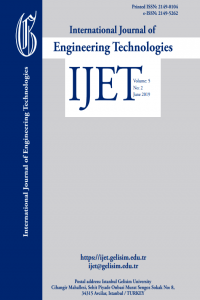Low Speed Numerical Aerodynamic Analysis of New Designed 3D Transport Aircraft
In this study a new airfoil is designed by using aerodynamic features of the NACA 0012 airfoil and numerical calculation is conducted by using Spalart–Allmaras Turbulence Model and calculated lift and drag coefficients are compare with experimental result to correlate numerical calculation accuracy of CDF model. Then, according to the new airfoil data, a three dimensional aircraft fuselage, and its wings are designed and, tail section is designed by using NACA 0012 airfoil. Finally, 3D model aircraft are simulated for cruise flight, climb and descent at the angle of attack +10 and -10 degrees respectively. The simulation results are interpreted in terms of fluid dynamics. It is observed that during the ascension and descent of the aircraft, very large vortices are formed by the low pressure effect occurring at the rear upper or lower part of the fuselage. Vortexes originating from the rear body are given with the wing tip vortexes in the same figures but the vortex due to the back of the fuselage is found to be very large compared to the wingtip. Furthermore, for each simulation, the formation of the wingtip vortexes are investigated and presented. It is observed that during ascending the vortex formation is formed in roll up and roll down in the phase of descending.
Keywords:
3D simulation, Aircraft, vortex, airfoil, Aerodynamic Analysis, lift drag,
___
- [1] C. R. Hanke and R. N. Donald, The Simulation Of A Jumbo Jet Transport Aircraft Volume I: Modeling Data, 1970, D6 -30643.[2] Florian R. Menter Review of the shear-stress transport turbulence model experience from an industrial perspective, International Journal of Computational Fluid Dynamics. 2009, 23:4, 305-316, DOI: 10.1080/10618560902773387. [3] A. Jameson, T. J. Baker and N. P. Weatherill. Calculation of Inviscid Transonic Flow over a Complete Aircraft, AIAA 24th Aerospace Sciences Meeting.1986, 86-0103.[4] J. Reuther,A. Jameson,J. Farmer,L. Martinelli,D. Saunders, Moffett Field, CAAerodynamic shape optimization of complex aircraft configurations via an adjoint formulation, AIAA Paper, 96-0094[5] Forrester T. Johnson , Edward N. Tinoco, N. Jong Yu. Thirty years of development and application of CFDat Boeing Commercial Airplanes, Seattle. Computers & Fluids 2005, 34 : 1115–1151.
- [6] B. Aupoix, P.R. Spalart, Extensions of the Spalart–Allmaras turbulence model to account for wall roughness. International Journal of Heat and Fluid Flow 2003;24 : 454–462.
- [7] D.C. Wilcox, Turbulence Modeling for CFD, 2nd ed., DCW Industries, 1998.
- [8] The Spalart-Allmaras Turbulence Model, NASA Langley Research Center. https://turbmodels.larc.nasa.gov
- [9] Allmaras, Steven R., Forrester T. Johnson, and Philippe R. Spalart. "Modifications and Clarifications for the Implementation of the Spalart-Allmaras Turbulence Model." Seventh International Conference on Computational Fluid Dynamics (ICCFD7). 2012.
- [10] Deck, S., Duveau, P., d'Espiney, P., & Guillen, P. (). Development and application of Spalart–Allmaras one equation turbulence model to three-dimensional supersonic complex configurations. Aerospace Science and Technology.2002, 6(3), 171-183.
- [11] 9. Ladson CL. Effects of Independent Variation of Mach and Reynolds Numbers on the Low-Speed Aerodynamic Characteristics of the NACA 0012 Airfoil Secti n. NASA TM 4074. (1988)
- ISSN: 2149-0104
- Başlangıç: 2015
- Yayıncı: İstanbul Gelişim Üniversitesi
